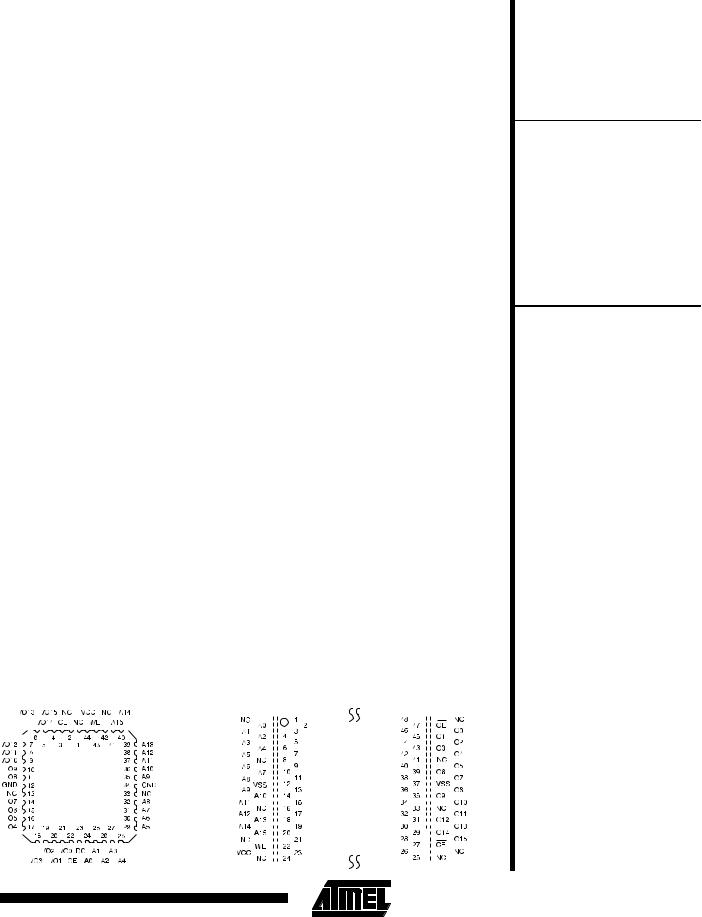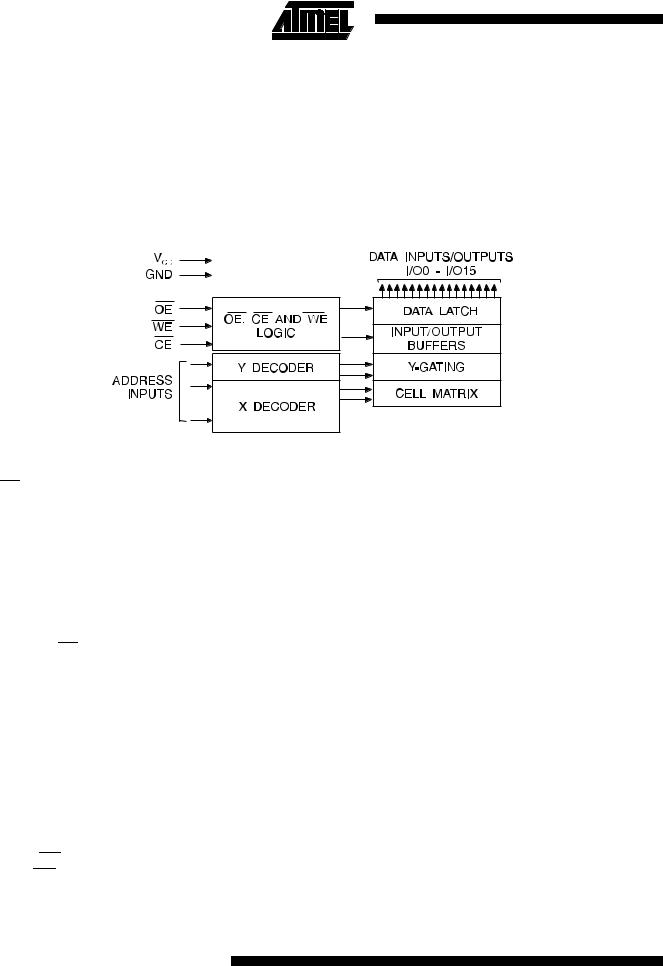ATMEL AT29C1024-90TI, AT29C1024-90TC, AT29C1024-90JI, AT29C1024-90JC, AT29C1024-70TI Datasheet
...
 AT29C1024
AT29C1024
Features
∙Fast Read Access Time - 70 ns
∙5-Volt-Only Reprogramming
∙Sector Program Operation
Single Cycle Reprogram (Erase and Program) 512 Sectors (128 words/sector)
∙ |
Internal Address and Data Latches for 128 Words |
Internal Program Control and Timer |
|
∙ |
Hardware and Software Data Protection |
∙ |
Fast Sector Program Cycle Time - 10 ms |
∙ |
DATA Polling for End of Program Detection |
∙ |
Low Power Dissipation |
60 mA Active Current
μ
∙Typical Endurance > 10,000 Cycles
∙Single 5V ±10% Supply
∙CMOS and TTL Compatible Inputs and Outputs
∙Commercial and Industrial Temperature Ranges200 A CMOS Standby Current
Description
The AT29C1024 is a 5-volt-only in-system Flash programmable and erasable read only memory (PEROM). Its 1 megabit of memory is organized as 65,536 words by 16 bits. Manufactured with Atmel’s advanced nonvolatile CMOS technology, the device offers access times to 70 ns with power dissipation of just 330 mW. When the device is deselected, the CMOS standby current is less than 200 μA. The device endurance is such that any sector can typically be written to in excess of 10,000 times.
(continued)
Pin Configurations
|
|
|
Pin Name |
|
|
|
Function |
|
|
|
|
|
|
|
|
|
|
|
||||||||||||||||||||||||||||||
|
|
|
A0 - A15 |
|
|
|
Addresses |
|
|
|
|
|
|
|
|
|
|
|
||||||||||||||||||||||||||||||
|
|
|
|
|
|
|
|
|
|
|
|
|
|
|
|
|
|
|
|
|
||||||||||||||||||||||||||||
|
|
|
|
|
|
|
|
|
|
|
|
|
|
|
|
|
|
|
|
|
||||||||||||||||||||||||||||
|
|
|
CE |
|
|
|
Chip Enable |
|
|
|
|
|
|
|
|
|
|
|
|
|
||||||||||||||||||||||||||||
|
|
|
|
|
|
|
|
|
|
|
|
|
|
|
|
|
|
|
|
|
||||||||||||||||||||||||||||
|
|
|
OE |
|
|
|
Output Enable |
|
|
|
|
|
|
|
|
|
|
|
|
|
||||||||||||||||||||||||||||
|
|
|
|
|
|
|
|
|
|
|
|
|
|
|
|
|
|
|
|
|||||||||||||||||||||||||||||
|
|
|
WE |
|
|
|
Write Enable |
|
|
|
|
|
|
|
|
|
|
|
|
|
||||||||||||||||||||||||||||
|
|
|
|
|
|
|
|
|
|
|
|
|
|
|
|
|
|
|
|
|
|
|
|
|
|
|
|
|
|
|
|
|
|
|
|
|||||||||||||
|
|
|
I/O0 - I/O15 |
|
|
|
Data |
|
|
|
|
|
|
|
|
|
|
|
||||||||||||||||||||||||||||||
|
|
|
|
|
|
Inputs/Outputs |
|
|
|
|
|
|
|
|
|
|
|
|
|
|||||||||||||||||||||||||||||
|
|
|
|
|
|
|
|
|
|
|
|
|
|
|
|
|
|
|
|
|
|
|
|
|
|
|
|
|
|
|
|
|
|
|
||||||||||||||
|
|
|
NC |
|
|
|
No Connect |
|
|
|
|
|
|
|
|
|
|
|
||||||||||||||||||||||||||||||
|
|
|
DC |
|
|
|
Don’t Connect |
|
|
|
|
|
|
|
|
|
|
|
||||||||||||||||||||||||||||||
|
|
|
|
|
|
|
|
|
|
|
|
|
|
|
|
|
|
|
|
|
|
|
|
|
|
|
|
|
|
|
|
|
|
|
|
|
|
|
|
|
TSOP Top View |
|
||||||
|
|
|
|
|
|
|
|
|
|
PLCC Top View |
|
|
|
|||||||||||||||||||||||||||||||||||
|
|
|
|
|
|
|
|
|
|
|
|
Type 1 |
|
|||||||||||||||||||||||||||||||||||
|
|
|
|
|
|
|
|
|
|
|
|
|
|
|
|
|
|
|
|
|
|
|
|
|
|
|
|
|
|
|
|
|
|
|
|
|
|
|
|
|
|
|
|
|
|
|
|
|
|
|
|
|
|
|
|
|
|
|
|
|
|
|
|
|
|
|
|
|
|
|
|
|
|
|
|
|
|
|
|
|
|
|
|
|
|
|
|
|
|
|
|
|
|
|
|
|
|
|
|
|
|
|
|
|
|
|
|
|
|
|
|
|
|
|
|
|
|
|
|
|
|
|
|
|
|
|
|
|
|
|
|
|
|
|
|
|
|
|
|
|
|
|
|
|
|
|
|
|
|
|
|
|
|
|
|
|
|
|
|
|
|
|
|
|
|
|
|
|
|
|
|
|
|
|
|
|
|
|
|
|
|
|
|
|
|
|
|
|
|
|
|
|
|
|
|
|
|
|
|
|
|
|
|
|
|
|
|
|
|
|
|
|
|
|
|
|
|
|
|
|
|
|
|
|
|
|
|
|
|
|
|
|
|
|
|
|
|
|
|
|
|
|
|
|
|
|
|
|
|
|
|
|
|
|
|
|
|
|
|
|
|
|
|
|
|
|
|
|
|
|
|
|
|
|
|
|
|
|
|
|
|
|
|
|
|
|
|
|
|
|
|
|
|
1 Megabit
(64K x 16)
5-volt Only CMOS Flash Memory
0571A
4-141

Description (Continued)
To allow for simple in-system reprogrammability, the AT29C1024 does not require high input voltages for programming. Five-volt-only commands determine the operation of the device. Reading data out of the device is similar to reading from an EPROM. Reprogramming the AT29C1024 is performed on a sector basis; 128 words of data are loaded into the device and then simultaneously programmed.
Block Diagram
Device Operation
READ: The AT29C1024 is accessed like an EPROM. When CE and OE are low and WE is high, the data stored at the memory location determined by the address pins is asserted on the outputs. The outputs are put in the high impedance state whenever CE or OE is high. This dualline control gives designers flexibility in preventing bus contention.
DATA LOAD: Data loads are used to enter the 128 words of a sector to be programmed or the software codes for data protection. A data load is performed by applying a low pulse on the WE or CE input with CE or WE low (respectively) and OE high. The address is latched on the falling edge of CE or WE, whichever occurs last. The data is latched by the first rising edge of CE or WE.
PROGRAM: The device is reprogrammed on a sector basis. If a word of data within a sector is to be changed, data for the entire sector must be loaded into the device. Any word that is not loaded during the programming of its sector will be erased to read FFH. Once the words of a sector are loaded into the device, they are simultaneously programmed during the internal programming period. After the first data word has been loaded into the device, successive words are entered in the same manner. Each new word to be programmed must have its high to low transition on WE (or CE) within 150 μs of the low to high transition of WE (or CE) of the preceding word. If a high to low transition is not detected within 150 μs of the last low to high transition, the load period will end and the internal programming period will start. A7 to A15 specify the sector
4-142 AT29C1024
During a reprogram cycle, the address locations and 128 words of data are internally latched, freeing the address and data bus for other operations. Following the initiation of a program cycle, the device will automatically erase the sector and then program the latched data using an internal control timer. The end of a program cycle can be detected by DATA polling of I/O7 or I/O15. Once the end of a program cycle has been detected, a new access for a read or program can begin.
address. The sector address must be valid during each high to low transition of WE (or CE). A0 to A6 specify the word address within the sector. The words may be loaded in any order; sequential loading is not required. Once a programming operation has been initiated, and for the duration of tWC, a read operation will effectively be a polling operation.
SOFTWARE DATA PROTECTION: A software controlled data protection feature is available on the AT29C1024. Once the software protection is enabled a software algorithm must be issued to the device before a program may be performed. The software protection feature may be enabled or disabled by the user; when shipped from Atmel, the software data protection feature is disabled. To enable the software data protection, a series of three program commands to specific addresses with specific data must be performed. After the software data protection is enabled the same three program commands must begin each program cycle in order for the programs to occur. All software program commands must obey the sector program timing specifications. Once set, software data protection will remain active unless the disable command sequence is issued. Power transitions will not reset the software data protection feature, however the software feature will guard against inadvertent program cycles during power transitions.
(continued)

Device Operation (Continued)
After setting SDP, any attempt to write to the device without the 3-word command sequence will start the internal write timers. No data will be written to the device; however, for the duration of tWC, a read operation will effectively be a polling operation.
After the software data protection’s 3-word command code is given, a sector of data is loaded into the device using the sector programming timing specifications.
HARDWARE DATA PROTECTION: Hardware features protect against inadvertent programs to the AT29C1024 in the following ways: (a) VCC sense— if V CC is below 3.8V (typical), the program function is inhibited. (b) VCC power on delay— once V CC has reached the VCC sense level, the device will automatically time out 5 ms (typical) before programming. (c) Program inhibit— holding any one of OE low, CE high or WE high inhibits program cycles. (d) Noise filter— pulses of less than 15 ns (typical) on the WE or CE inputs will not initiate a program cycle.
PRODUCT IDENTIFICATION: The product identification mode identifies the device and manufacturer as Atmel. It may be accessed by hardware or software operation. The hardware operation mode can be used by an external programmer to identify the correct programming algorithm for the Atmel product. In addition, users may wish to use the software product identification mode to identify the part (i.e. using the device code), and have the system software use the appropriate sector size for program op-
Absolute Maximum Ratings*
Temperature Under Bias |
................. -55°C to +125°C |
||
Storage Temperature...................... |
-65°C to +150°C |
||
All Input Voltages |
|
||
(including NC Pins) |
|
||
with Respect to Ground ................... |
-0.6V to +6.25V |
||
All Output Voltages |
|
||
with Respect to Ground ............. |
- 0.6V to VCC + 0.6V |
||
|
|
|
|
Voltage on OE |
|
||
with Respect to Ground ................... |
-0.6V to +13.5V |
||
|
|
|
|
AT29C1024
erations. In this manner, the user can have a common board design for various Flash densities and, with each density’s sector size in a memory map, have the system software apply the appropriate sector size.
For details, see Operating Modes (for hardware operation) or Software Product Identification. The manufacturer and device code is the same for both modes.
DATA POLLING: The AT29C1024 features DATA polling to indicate the end of a program cycle. During a program cycle an attempted read of the last word loaded will result in the complement of the loaded data on I/O7 and I/O15. Once the program cycle has been completed, true data is valid on all outputs and the next cycle may begin. DATA polling may begin at any time during the program cycle.
TOGGLE BIT: I n a d d i t i o n t o DATA p o l li ng t he AT29C1024 provides another method for determining the end of a program or erase cycle. During a program or erase operation, successive attempts to read data from the device will result in I/O6 and I/O14 toggling between one and zero. Once the program cycle has completed, I/O6 and I/O14 will stop toggling and valid data will be read. Examining the toggle bit may begin at any time during a program cycle.
OPTIONAL CHIP ERASE MODE: The entire device can be erased by using a 6-byte software code. Please see Software Chip Erase application note for details.
*NOTICE: Stresses beyond those listed under “Absolute Maximum Ratings” may cause permanent damage to the device. This is a stress rating only and functional operation of the device at these or any other conditions beyond those indicated in the operational sections of this specification is not implied. Exposure to absolute maximum rating conditions for extended periods may affect device reliability.
4-143

DC and AC Operating Range
|
|
AT29C1024-70 |
AT29C1024-90 |
AT29C1024-12 |
AT29C1024-15 |
Operating |
Com. |
0°C - 70°C |
0°C - 70°C |
0°C - 70°C |
0°C - 70°C |
Temperature (Case) |
Ind. |
-40°C - 85°C |
-40°C - 85°C |
-40°C - 85°C |
-40°C - 85°C |
VCC Power Supply |
|
5V ± 5% |
5V ± 10% |
5V ± 10% |
5V ± 10% |
Operating Modes
Mode |
|
|
|
|
|
|
Ai |
I/O |
||
CE |
OE |
WE |
|
|||||||
Read |
VIL |
VIL |
VIH |
|
Ai |
DOUT |
||||
Program (2) |
VIL |
VIH |
VIL |
|
Ai |
DIN |
||||
5V Chip Erase |
VIL |
VIH |
VIL |
|
Ai |
|
||||
Standby/Write Inhibit |
VIH |
X (1) |
X |
|
X |
|
High Z |
|||
Program Inhibit |
X |
X |
VIH |
|
|
|
|
|
||
Program Inhibit |
X |
VIL |
X |
|
|
|
|
|
||
Output Disable |
X |
VIH |
X |
|
|
|
|
High Z |
||
Product Identification |
|
|
|
|
|
|
|
|
|
|
|
|
|
|
|
|
|
A1 - A15 = V |
IL |
, A9 = V , |
(3) |
|
|
|
|
|
|
|
|
H |
Manufacturer Code (4) |
|
Hardware |
VIL |
VIL |
VIH |
|
A0 = VIL |
|
||||
|
A1 - A15 = V |
IL |
, A9 = V , |
(3) |
||||||
|
|
|
|
|
|
|
|
H |
Device Code (4) |
|
|
|
|
|
|
|
|
A0 = VIH |
|
||
Software (5) |
|
|
|
|
|
|
A0 = VIL |
Manufacturer Code (4) |
||
|
|
|
|
|
|
A0 = VIH |
Device Code (4) |
|||
|
|
|
|
|
|
|
||||
Notes: 1. X can be VIL or VIH. |
|
|
|
|
|
4. Manufacturer Code: 1F, Device Code: 25 |
||||
2. Refer to AC Programming Waveforms. |
|
5. See details under Software Product Identification Entry/Exit. |
||||||||
3. VH = 12.0V ± 0.5V. |
|
|
|
|
|
|
|
|
|
|
DC Characteristics
Symbol |
Parameter |
Condition |
Min |
Max |
Units |
|
ILI |
Input Load Current |
VIN = 0V to VCC |
|
10 |
μA |
|
ILO |
Output Leakage Current |
VI/O = 0V to VCC |
|
10 |
μA |
|
ISB1 |
VCC Standby Current CMOS |
|
Com. |
|
200 |
μA |
|
|
|||||
CE = VCC - 0.3V to VCC |
|
200 |
μA |
|||
|
|
|
Ind. |
|
||
ISB2 |
|
|
|
|
|
|
VCC Standby Current TTL |
CE = 2.0V to VCC |
|
3 |
mA |
||
ICC |
VCC Active Current |
f = 5 MHz; IOUT = 0 mA |
|
60 |
mA |
|
VIL |
Input Low Voltage |
|
|
|
0.8 |
V |
VIH |
Input High Voltage |
|
|
2.0 |
|
V |
VOL |
Output Low Voltage |
IOL = 2.1 mA |
|
.45 |
V |
|
VOH1 |
Output High Voltage |
IOH = -400 μA |
2.4 |
|
V |
|
VOH2 |
Output High Voltage CMOS |
IOH = -100 μA; VCC = 4.5V |
4.2 |
|
V |
|
4-144 AT29C1024 
